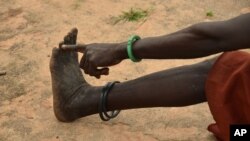A U.S.-based center says in a new report the eradication of the painful Guinea worm disease could be in sight.
The Carter Center, leader of the campaign to eliminate the disease, says there were only 30 identified cases of Guinea worm disease in isolated areas last year in Chad and Ethiopia - 15 in each country.
All the cases in Ethiopia occurred in migrant workers in the Oromia region who drank unfiltered water from a contaminated pond on an industrial farm.
Mali has not reported any cases of the disease in 25 months, while South Sudan, has not reported any cases in 13 months. The Carter Center labels those achievements by the two African countries as "major accomplishments."
There is no known vaccine or medicine to control Guinea worm disease. It is eradicated by educating people on how to filter and drink clean water.
People with Guinea worm disease have no symptoms for about one year, the U.S. Centers for Disease Control says. Then, a meter-long worm begins to emerge painfully and slowly from a blister that can form anywhere on the body. In 80 to 90 percent of the cases, the blister forms on lower body parts.
"It was more painful than giving birth," a South Sudan woman told the Associated Press last year. "Childbirth ends, but this pain persists."
If the worm breaks during removal, it can cause intense inflammation as the remaining part of the worm degrades in the body.
The worm removal and recovery can disable people, sometimes permanently.
The Carter Center, founded by former U.S. president Jimmy Carter and his wife Rosalynn, reports that in 1986 Guinea worm disease affected an estimated 3.5 million people in 21 countries in Africa and Asia. The incidence of the disease has now been reduced by more than 99.999 percent "thanks to the work of strong partnerships, including the countries themselves," the center said.
US Group: Eradication of Painful Guinea Worm Disease in Sight
- By VOA News
